Nonprofit Management Certificate. Learn How to Design, Fund and Manage Nonprofit Programs
OL 240: Online Certificate Program: A Certificate Program of 4, 8-Week Courses.
Current start dates are listed in the sidebar.
Expand on this nonprofit management certificate, Design, Fund and Manage Nonprofit Programs, through a live workshop.
| Develop a Real Non Profit Project and learn how to Manage and Design Non Profit Programs with your own CSDi Coach and Mentor. Learn more about program fees and how to enroll here: |
 |
|
Nonprofit job skills you will learn:
Great Program Design = New Funding + Increased Services Develop a winning, impact oriented project while learning to:
|
|
Who Should Join?
Advance your Career, Fund Nonprofit Organizations, Solve Challenges The program is for non profit staff and job-seekers wanting to successfully solve community challenges, learn non profit program design and fund nonprofits. Participants have worked on programs as diverse as social services, community development, education, the environment, and social justice—and decided to enroll in the program because they were:
|
What you will Do:
Design your own Solution-Oriented Project & Attract Donors The 4 courses in the program provide cutting-edge information on how to design and manage nonprofit programs, time-saving templates, training and expert consultancy—and lead you in developing a real project for your organization. You will:
Each 8-week course costs $150.00 and begins monthly.
|
- in 201, design a project using evidence-based activities
- in 202, develop presentations for donor communications
- in 203, build project impact through community engagement
- in 204, learn how to launch and manage your project
- in 203, build project impact through community engagement
- in 204, learn how to launch and manage non profit programs
“I just want to take this opportunity to complement you on the practical ideas, knowledge and vast experience that you continue to share with us on each assignment. Many times your examples are the solution of choice for our community. I have been provided with constant support, practical solutions suitable for my project, feedback specific to our project submissions and unwavering encouragement.” Gillian Primus
| Subscribe! Join a community of nonprofit communication specialists to get cutting-edge articles on advancing your career, raising more funds, and connecting with donors. |  |
If you work with a non profit on programs such as animal welfare, community development, the environment—or a food bank or homeless shelter—the Nonprofit Management Certificate Program 240 will help you develop sustainable, fundable, impact oriented projects.
Non profit organizational effectiveness in these kinds of programs can be limited by non profit staff’s poor access to mission-critical information and training. We deliver solutions by providing information, tools, time-saving templates, training and expert consultancy through blending direct communication, distance learning and e learning—and lead you in developing a real project for your organization.
- Maybe you don’t have enough funding for all of the services you would like to provide
- At times project impact has been low—and sustainability is elusive
- Perhaps your staffing is low and you can’t find enough time to get everything done
- Manage non profit programs: Sometimes projects can be difficult to manage—sometimes projects stall mid-term
- It’s possible that your donor communications need to be improved and targeted for better donor engagement
- Empower people in your communities to change their lives,
- develop impact-oriented projects from the ground-up,
- use proven methods that produce sustainable results,
- attract donors, and
- collaborate with course colleagues.
- urban agriculturalists
- teenagers visiting a teen drop-in center
- people visiting a food bank
- recent immigrants learning to navigate a new country and a new culture
- members of a town developing a trail system in an adjacent wilderness area
- members of a small town in Nebraska in the process of revitalizing it
- citizens trying to fund a community health center
- local farmers forming a marketing association
- young families in need of day care
| OL 201: Design and Manage Nonprofit Projects—From the Ground Up | |
 |
Nonprofit Online Certificate. The course will lead you through the development of a real project, in real time, and leave you with the practical tools to sustain it.
We are committed to results-based programs. You will learn to incorporate community-identified need into the design of your project and research project activities that have shown evidence of having worked at solving challenges.
|
| OL 202: Design and Manage Nonprofit Programs—Planning for Impact | |
 |
Embed impact into your project design with a powerful set of nonprofit management tools. Log frames, detailed budgets, timelines, a project description, compelling fact sheets, M&E plans, and outcome and impact statements. Learn steps to take now in preparation for painless project reporting later.
|
| OL 203: Design and Manage Nonprofit Programs—The Community Focus | |
 |
What are the clear definitions of the problem at the community level? What practical tools are available today for staff members to use in nonprofit program design? For practitioners who wish to begin working now at the community level to successfully solve the challenges that they face.
|
| OL 204: Design and Manage Nonprofit Programs—Sustainable Implementation | |
 |
How do you best launch and manage nonprofit programs? The importance of community engagement and project co-management. Developing skill sets for your community to use in the project. Learning tools: monitoring & evaluation. Community empowerment through sustainability, follow-up & mentoring. In this course you will design and lead a capacity building workshop.
|
- Are you considering a career change, a new job search, or vying for a promotion?
- Would you like to boost your proposal writing & non profit project management skill sets to raise more funds?
- Would you like to learn how to increase donations for nonprofits?
- Would you like to learn more about designing nonprofit projects and implementing impact-oriented, non profit projects?
 |
Course Facilitation
The Nonprofit Management Certificate Program, Design and Manage Nonprofit Programs, will be led by Tim Magee, CSDi’s Executive Director, who has over 30 years experience in both working with nonprofits and leading nonprofit training programs. Mr. Magee is the author of A Field Guide to Community Based Adaptation published by Routledge, Oxford, England. Through this program Mr. Magee will give you dedicated help in:
|
- Improving project design, management, impact and sustainability
- Increase donations by creating better communication and engagement with donors
- Week 1 Learn to navigate the course website, download the week’s documents, and form partnerships.
- Week 2 & 3 Clearly identify the community that you hope to work with in the nonprofit needs assessment. Read the document on participatory needs assessments and conduct an informal assessment with a few community members to uncover a real challenge. List the needs identified and organize them into a clearly described nonprofit challenge that you are going to solve with your project design. We want this as real as possible.
- Week 4 Develop a theory of how you plan to solve your new challenge, and research 3 solution-oriented activities that would fulfill the premise of your theory.
- Week 5 Research one peer-reviewed paper for each of your three project activities and see if scientists have found evidence that your proposed activities have been effective in solving the challenge. Write a one paragraph summary of the papers’ findings.
- Week 6
- Share your proposed project concept locally with colleagues to gain feedback and constructive criticism.
- Return to the community with your project concept and get their feedback and hopeful buy-in.
- Pick one of your evidence-based activities and write a simple one page guide on how a field staff person could implement it.
- Week 7 Write a workshop lesson plan for introducing this activity into a community, and then make an illustrated, How-to card to give to community members.
- Week 8
- Share your project with someone that you would like to sell it to: a donor, your boss, your professor, someone in the development/nonprofit world for feedback.
- Lay out your challenge, proposed solutions, and activities in a simple matrix (logistic framework) that I will supply. This will prepare you for the next course: OL 202 where you will transform your project into a set of management documents that can formally be presented to fund programs.
Week 1. We will take the project challenge, proposed solution, and activities that you developed in OL 201, and transform them into a simplified logframe.
Week 2.
1. The focus will be on outcomes and impact, how the current world of development sees them. We will see how we can use them to improve the logframe.
2. We will incorporate outcome and impact statements into the logframe, and begin adding indicators and means of verification in preparation for developing a monitoring and evaluation plan.
Week 3. We will take the activity list from the logframe and create a budget, and then apply costs to each of the different activities.
Week 4.
We will take our detailed budget and transform it into a visual timeline/schedule.
Week 5.
1. You will each write a compelling project fact sheet for presentation to donors that is no longer than 2 pages. This concise, quick-to-read document can present a focused message to a donor.
2. Make a list of 2 colleagues, 2 potential non profit partners, and two donors that you can share this working project proposal with. Make an appointment with 1 of them.
Week 6.
1. Share your project informally with a donor, your boss, your professor, someone in the development world for feedback. We will discuss why it is a good idea to visit a donor at this preliminary stage, and why you should wait on writing an actual proposal.
2. We will polish this family of documents by including the constructive feedback, and by making sure that the docs are absolutely parallel to each other. We will then carefully print them out and make an appointment with a donor to present your project.
 |
Week 1: Design a Participatory Community Workshop to share information, collect local knowledge and to learn about community vulnerability, assets and traditional strategies; develop a Baseline Survey to better understand pressing local needs. Download and adapt a Workshop Lesson Plan. |
 |
Week 2: Community. Lead the participatory workshop. Present a range of potential community -based activities. Encourage feedback: What needs and perceptions did community members express? Start the buy-in process. Conduct the Baseline Survey. |
 |
Week 3: Project Refinement. Use the community feedback & baseline results to incorporate activities into your project designed to strengthen the community. Research scientifically-based best practices and solutions to the community’s special problems. Can these work alongside and/or support local strategies? |
 |
Week 4: Feedback and Ownership. Incorporate your refined strategies into your project logframe, budget and schedule. Return to the community for feedback on your design. Show how your strategies can work to solve their special challenges. |
 |
Week 5. Sustainability. Plan and organize a workshop to develop a community-based project team. Prepare a presentation that uses appropriate knowledge transfer techniques. Partner with experts in the specialties you intend to offer to the community. |
 |
Week 6. Leadership. Team Building Workshop. Develop a community-based planning and oversight committee – the community team that you will partner with. Examples could be a committee on activities for the elderly, alternative transportation, bicycle paths, business skills training for immigrants, community development, conservation, elderly care facilities, financial literacy, recycling, or youth employment. |
 |
Week 1: Non Profit Project Management – the community perspective. Managing a project whose outcomes are projected in terms of decades needs to be carefully planned. If we play too large a role in the project process, it will make it more difficult for the community to take over when we leave. |
 |
Week 2: Engaging the community in project launch. If we’ve planned the project properly the community will think that this is their project and that we’re just there to provide the service they requested. We need to maintain that relationship in order to ensure that the community is fully engaged in the process. |
 |
Week 3: Skill Sets. Design a family of workshops on the solutions your community will use in the project. The solution activities we select need to be able to be implemented by a broad range of people types. These workshops will provide the community with all the information that they need to continue these activities for decades. |
 |
Week 4: Project Launch. Lead the participatory workshop and introduce the community based skills designed to address the community expressed needs. Continue to encourage community feedback to develop lessons learned and to continue building community ownership of the process. |
 |
Week 5. Learning tools: Monitoring and evaluation. In the last course we conducted a baseline survey. We now need to do two things: determine what information we’re looking for in order to evaluate short-term outputs and long-term impact, and manage the process of collecting this information. |
 |
Week 6. Community Empowerment: Project hand-over. Our 3 years is up, our budget spent & it’s time to leave. Have we empowered the community to participate in outcome continuation at this point? Have we worked with them to identify milestones that will allow them to stay on track? Can we provide follow-up without taking the project back? Have we introduced supporting partners where they can seek future technical support? |
| Develop a Real Non Profit Project with your own CSDi Coach and Mentor while you learn about non profit program planning. |
 |
|
This CSDi training program is offered in 4 venues to best suit your needs:
|
“Thank you for all your effort in putting together a great program and all of the program resources. Thank you for everything – for making this possible, for your guidance, and for your continuous optimism and encouragement. I look forward to the opportunity to work with you again in the next session.” Wye Yee
“As you know, as a real beginner in designing non profit projects, without your project example templates I could never have written even a single word by myself.” Moise
“I wish to extend my heartfelt gratitude for the knowledge addition to our careers and the time you take to correct our assignments. This has opened doors for us to venture into designing our own projects, and I’m very sure we shall never go POOR. You’ve indeed taught us how to FISH—not provided FISH.” Dianah
“This program was absolutely awesome! The course content, instruction, example projects, on-line resources and the most valuable – your timely guidance on the assignments were all perfectly done.” Boris
“I’m so excited with the whole experience this training has provided me. The interaction with the community, sharing their lives, their enthusiasm in participating and opening up to me – and with lots of hope in seeing me engage with them.” George
“This training program is an absolute cracker. After undertaking the course, I was able to relate and transform community need into a project idea that could attract donor funding. The exercise of transforming goals into a simple logical framework was particularly exhilarating and smooth. It was indeed an eye opener for me.” Perry
